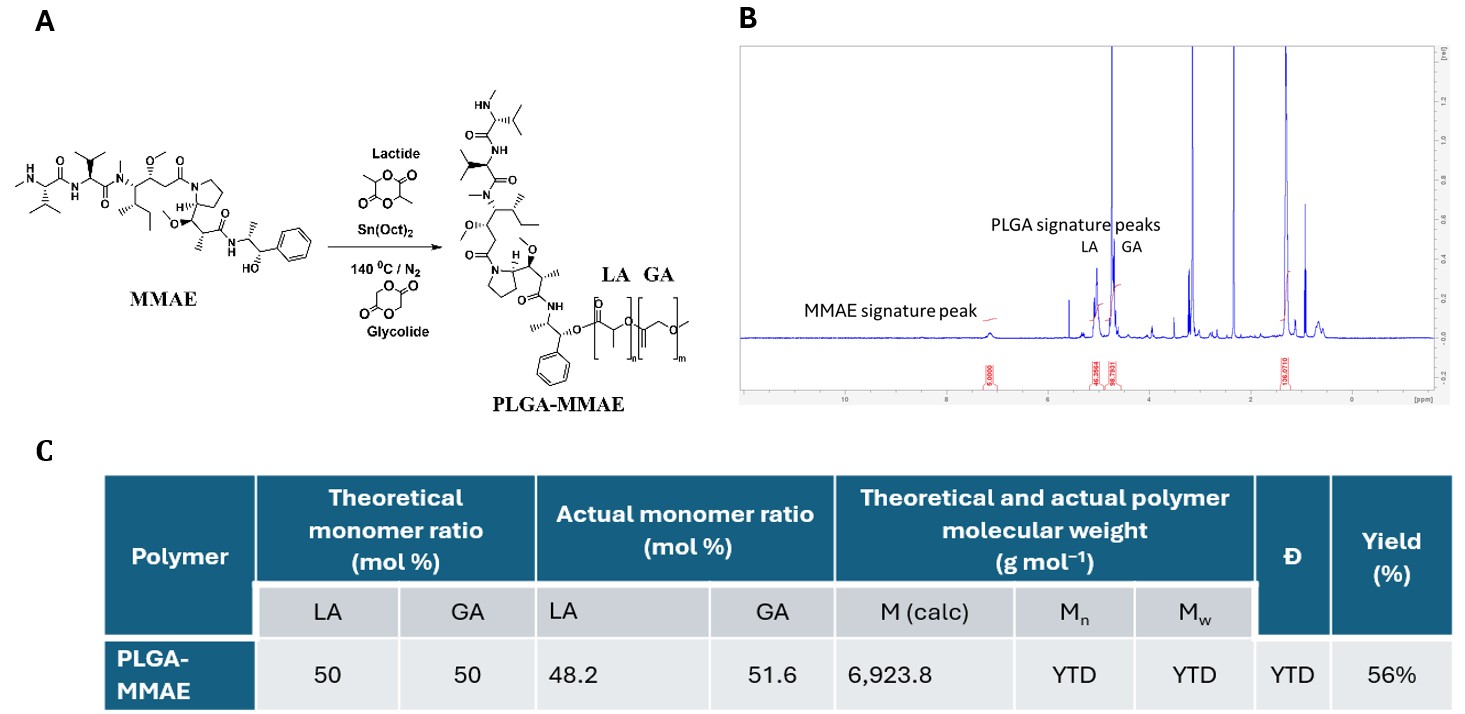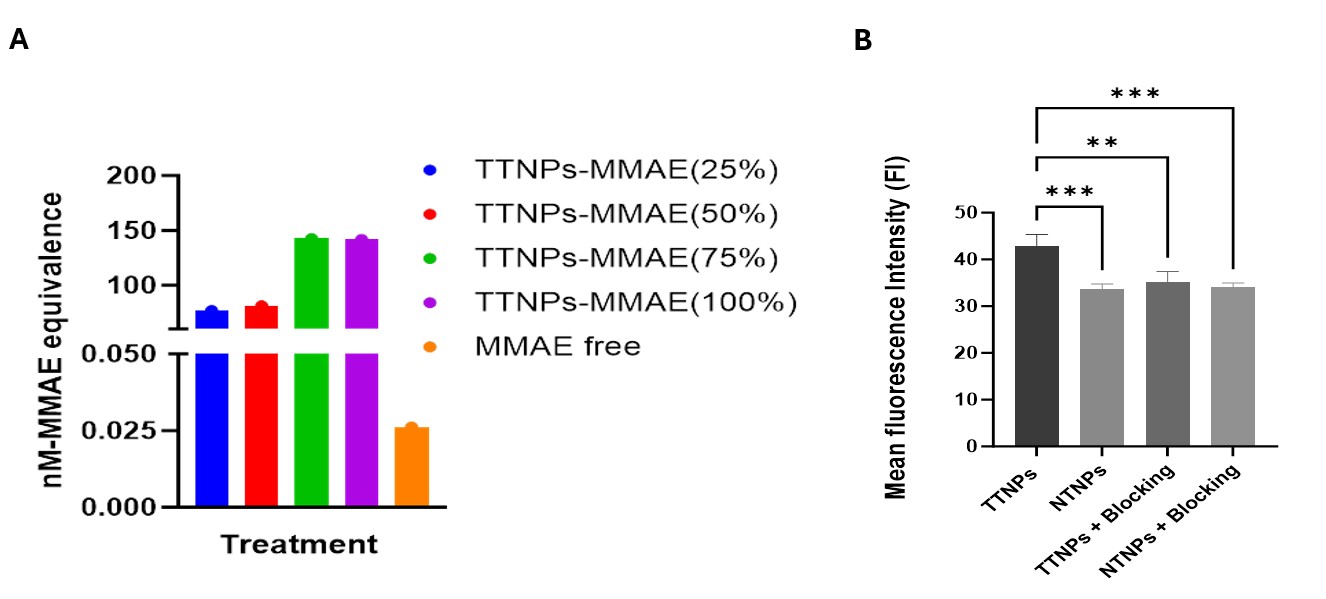Formulation and Delivery - Chemical
(W0930-08-49) Engineering Biodegradable Polymer–Drug Conjugates for Precision Oncology Nanomedicine
Wednesday, November 12, 2025
9:30 AM - 10:30 AM CT

Mohammad Alnatour, PhD
Postdoctoral Research Scholar
University of Iowa
Iowa City, Iowa, United States
Mohammad Alnatour, PhD
Postdoctoral Research Scholar
University of Iowa
Iowa City, Iowa, United States- PP
Pornpoj Phruttiwanichakun, Pharm.D., M.Sc. (they/them/theirs)
Graduate student
University of Iowa
Iowa City, Iowa, United States - SG
Sean Geary, Ph.D.
Assistant Research Scientist/Lab Manager
University of Iowa
Iowa City, Iowa, United States - SR
Sen Ramkrishna, Ph.D.
Postdoctoral researcher
University of Iowa
Iowa City, Iowa, United States 
Aliasger K. Salem, PhD
Bighley Chair and Professor of Pharmaceutical Sciences
University of Iowa
Iowa City, Iowa, United States
Presenting Author(s)
Main Author(s)
Co-Author(s)
Purpose: Potent chemotherapeutic agents often exhibit significant off-target toxicity, limiting their clinical utility. A widely adopted strategy to mitigate this issue involves covalently conjugating these drugs to polymers or biomolecules, thereby rendering the payload inactive until metabolized under physiological conditions—ideally after reaching target tissues or being internalized by cancer cells. In this study, we report the development of a modular platform for synthesizing polymer–drug conjugates (PDCs) for targeted cancer nanomedicine. Using monomethyl auristatin E (MMAE) as a model cytotoxic agent, and poly(lactic-co-glycolic acid) (PLGA) as the polymer, PLGA–MMAE conjugates were synthesized via ring-opening polymerization (ROP), achieving high drug-to-carrier ratios (DCR ~440). These PDCs self-assemble into nanoparticles (NPs) and can be functionalized with tumor-targeting ligands such as cetuximab. The resulting tumor-targeted nanoparticles (TTNPs) demonstrated potent anticancer activity in vitro and significant tumor regression and survival benefits in vivo in a HT29 colorectal cancer xenograft model. This platform offers a scalable and adaptable approach for precision oncology with improved safety and efficacy profiles.
Methods: PLGA–MMAE PDCs were synthesized via ROP using MMAE’s hydroxyl group to initiate polymerization of D,L-lactide and glycolide (1:1 molar ratio), catalyzed by Sn(Oct)₂ at 140°C under nitrogen. The reaction proceeded for 3 hours, followed by overnight polymerization, and the product was purified via acetone dissolution and ether precipitation. NPs were formulated by nanoprecipitation using blends of PDC, Resomer® RG 502 H, and PLGA–PEG–COOH, with PDC content ranging from 25–100%. The polymer mixture in DMSO was injected into 1% TPGS solution, dialyzed, concentrated, and freeze-dried. NP size, zeta potential, morphology, and drug loading were characterized using DLS, TEM, and HPLC. Fluorescently labeled NPs were prepared with Coumarin 6, and TTNPs were generated by conjugating cetuximab (anti-EGFR) via EDC/sulfo-NHS chemistry. Conjugation efficiency was assessed using a Micro BCA™ assay. HT29 colorectal cancer cells were cultured in RPMI 1640 with 10% FBS and 50 µg/mL gentamicin. Cytotoxicity was evaluated using a PrestoBlueTM assay after 72-hour treatment with TTNPs (0.01 ng/mL to 1 mg/mL), and IC₅₀ values were calculated. Cellular uptake was quantified by flow cytometry using fluorescent TTNPs and non-targeted NPs (NTNPs), with EGFR blocking confirming EGFR-specific targeting. For in vivo studies, HT29 cells (5×10⁶) were subcutaneously injected into nude mice. Upon tumor growth to ~200 mm³, mice were randomized into TTNP, NTNP, and control groups (n=9/group), and treated via tail vein injection on days 0 and 7. Tumor volume was calculated using caliper measurements (π/6 × D1 × D2 × H), and survival and body weight were monitored to assess therapeutic efficacy and safety.
Results: 1H NMR spectroscopy confirmed successful synthesis of PLGA–MMAE conjugates, showing characteristic peaks for lactic acid (CH₃ at 1.5 ppm, CH at 5.2 ppm), glycolic acid (CH₂ at 4.8 ppm), and MMAE aromatic protons (7.15 ppm). These spectral features enabled precise determination of monomer ratios and molecular weight, validating the ROP strategy. The resulting conjugates self-assembled into NPs with uniform size (~100–150 nm) and negative zeta potential. Cetuximab was efficiently conjugated to the NP surface, yielding stable TTNPs. In vitro cytotoxicity studies using HT29 cells demonstrated that MMAE retained its anticancer activity post-conjugation, with TTNPs exhibiting IC₅₀ values between 70–140 nM, equivalent to MMAE content, while free MMAE showed an IC₅₀ of 0.02 nM, indicating excessive toxicity in its unconjugated form. TTNPs with 25% and 50% PDC content were more effective than higher PDC ratios, suggesting an optimal balance between drug loading and NP stability. Flow cytometry revealed enhanced cellular uptake of fluorescently labeled TTNPs in EGFR-positive HT29 cells, which was significantly reduced upon EGFR receptor blocking with free cetuximab, confirming targeting specificity. In vivo, TTNPs administered intravenously to HT29 xenograft-bearing nude mice induced marked tumor regression and extended median survival to 31 days, outperforming NTNPs (17 days) and untreated controls (21 days), with no observable toxicity or weight loss. These findings underscore the therapeutic potential of PLGA–MMAE TTNPs as a safe and effective nanomedicine for colorectal cancer.
Conclusion: This study demonstrates the successful development of a modular PLGA/MMAE-based polymer–drug conjugate platform capable of achieving targeted delivery, and potent anticancer efficacy. TTNPs synthesized using PDC and functionalized with cetuximab showed enhanced tumor selectivity, reduced systemic toxicity, and significant therapeutic benefit in colorectal cancer models. These findings support the translational promise of PLGA–PDC nanomedicines as a scalable and versatile alternative to conventional ADCs for precision oncology.
Acknowledgements: This work was funded by Gastrointestinal Research Foundation
 Figure 1: A) Schematic representation of PLGA-MMAE PDC synthesis using ROP reaction. The ROP reaction was conducted at 140 °C under dry nitrogen gas with tin(II) 2-ethylhexanoate (Sn(Oct)2) as the catalyst. B) 1H NMR spectrum of purified PLGA-MMAE PDC in DMSO-d6 (prepared by ROP as described earlier; MMAE acts as the initiator of ROP reaction. C) A table summarizing PLGA-MMAE PDC characteristics based on 1H-NMR analysis and theoretical values (M(calc) is the PDC molecular weight calculated using the 1H-NMR result).
Figure 1: A) Schematic representation of PLGA-MMAE PDC synthesis using ROP reaction. The ROP reaction was conducted at 140 °C under dry nitrogen gas with tin(II) 2-ethylhexanoate (Sn(Oct)2) as the catalyst. B) 1H NMR spectrum of purified PLGA-MMAE PDC in DMSO-d6 (prepared by ROP as described earlier; MMAE acts as the initiator of ROP reaction. C) A table summarizing PLGA-MMAE PDC characteristics based on 1H-NMR analysis and theoretical values (M(calc) is the PDC molecular weight calculated using the 1H-NMR result).
 Figure 2: A) IC50 values of TTNPs made of different fractions of PDC, calculated based on the equivalent amount of MMAE content. B) NP uptake assay: Flow cytometric relative mean fluorescence intensities of HT29 cells treated with fluorescently labelled TTNPs, NTNPs, TTNPs + EGFR blocking and NTNPs + EGFR blocking, at a concentration 100 µg/mL for 1 hour. n=4, one-way ANOVA, ** p-value < 0.01, *** p-value < 0.001
Figure 2: A) IC50 values of TTNPs made of different fractions of PDC, calculated based on the equivalent amount of MMAE content. B) NP uptake assay: Flow cytometric relative mean fluorescence intensities of HT29 cells treated with fluorescently labelled TTNPs, NTNPs, TTNPs + EGFR blocking and NTNPs + EGFR blocking, at a concentration 100 µg/mL for 1 hour. n=4, one-way ANOVA, ** p-value < 0.01, *** p-value < 0.001
 Figure 3: A) Tumor growth profiles for HT29 tumor-bearing nude mice, I.V. injected with TTNPs or NTNPs equivalent to ~0.13 mg of MMAE per mouse (6.5 mg-MMAE/kg) or untreated control (n = 9 per group). Two doses on Day 0 and Day 7. Statistical analysis was performed using a one-way ANOVA. Data are presented as mean ± SEM. * p-value < 0.05, ** p-value < 0.01, *** p-value <0.0001. B) Kaplan–Meier survival curves that compare variously treated mice with the control group. Values of median survival are shown in brackets. C) Mice weight change over time during treatments. Mice were weighed every 3-4 days. Data are presented as mean ± SEM. **** p-value < 0.0001. E) Kaplan–Meier survival curves that compare variously treated mice with the control group. Values of median survival are shown in brackets. F) Mice weight change over time during treatments. Mice were weighed every 3-4 days. Data are presented as mean ± SEM.
Figure 3: A) Tumor growth profiles for HT29 tumor-bearing nude mice, I.V. injected with TTNPs or NTNPs equivalent to ~0.13 mg of MMAE per mouse (6.5 mg-MMAE/kg) or untreated control (n = 9 per group). Two doses on Day 0 and Day 7. Statistical analysis was performed using a one-way ANOVA. Data are presented as mean ± SEM. * p-value < 0.05, ** p-value < 0.01, *** p-value <0.0001. B) Kaplan–Meier survival curves that compare variously treated mice with the control group. Values of median survival are shown in brackets. C) Mice weight change over time during treatments. Mice were weighed every 3-4 days. Data are presented as mean ± SEM. **** p-value < 0.0001. E) Kaplan–Meier survival curves that compare variously treated mice with the control group. Values of median survival are shown in brackets. F) Mice weight change over time during treatments. Mice were weighed every 3-4 days. Data are presented as mean ± SEM.
Methods: PLGA–MMAE PDCs were synthesized via ROP using MMAE’s hydroxyl group to initiate polymerization of D,L-lactide and glycolide (1:1 molar ratio), catalyzed by Sn(Oct)₂ at 140°C under nitrogen. The reaction proceeded for 3 hours, followed by overnight polymerization, and the product was purified via acetone dissolution and ether precipitation. NPs were formulated by nanoprecipitation using blends of PDC, Resomer® RG 502 H, and PLGA–PEG–COOH, with PDC content ranging from 25–100%. The polymer mixture in DMSO was injected into 1% TPGS solution, dialyzed, concentrated, and freeze-dried. NP size, zeta potential, morphology, and drug loading were characterized using DLS, TEM, and HPLC. Fluorescently labeled NPs were prepared with Coumarin 6, and TTNPs were generated by conjugating cetuximab (anti-EGFR) via EDC/sulfo-NHS chemistry. Conjugation efficiency was assessed using a Micro BCA™ assay. HT29 colorectal cancer cells were cultured in RPMI 1640 with 10% FBS and 50 µg/mL gentamicin. Cytotoxicity was evaluated using a PrestoBlueTM assay after 72-hour treatment with TTNPs (0.01 ng/mL to 1 mg/mL), and IC₅₀ values were calculated. Cellular uptake was quantified by flow cytometry using fluorescent TTNPs and non-targeted NPs (NTNPs), with EGFR blocking confirming EGFR-specific targeting. For in vivo studies, HT29 cells (5×10⁶) were subcutaneously injected into nude mice. Upon tumor growth to ~200 mm³, mice were randomized into TTNP, NTNP, and control groups (n=9/group), and treated via tail vein injection on days 0 and 7. Tumor volume was calculated using caliper measurements (π/6 × D1 × D2 × H), and survival and body weight were monitored to assess therapeutic efficacy and safety.
Results: 1H NMR spectroscopy confirmed successful synthesis of PLGA–MMAE conjugates, showing characteristic peaks for lactic acid (CH₃ at 1.5 ppm, CH at 5.2 ppm), glycolic acid (CH₂ at 4.8 ppm), and MMAE aromatic protons (7.15 ppm). These spectral features enabled precise determination of monomer ratios and molecular weight, validating the ROP strategy. The resulting conjugates self-assembled into NPs with uniform size (~100–150 nm) and negative zeta potential. Cetuximab was efficiently conjugated to the NP surface, yielding stable TTNPs. In vitro cytotoxicity studies using HT29 cells demonstrated that MMAE retained its anticancer activity post-conjugation, with TTNPs exhibiting IC₅₀ values between 70–140 nM, equivalent to MMAE content, while free MMAE showed an IC₅₀ of 0.02 nM, indicating excessive toxicity in its unconjugated form. TTNPs with 25% and 50% PDC content were more effective than higher PDC ratios, suggesting an optimal balance between drug loading and NP stability. Flow cytometry revealed enhanced cellular uptake of fluorescently labeled TTNPs in EGFR-positive HT29 cells, which was significantly reduced upon EGFR receptor blocking with free cetuximab, confirming targeting specificity. In vivo, TTNPs administered intravenously to HT29 xenograft-bearing nude mice induced marked tumor regression and extended median survival to 31 days, outperforming NTNPs (17 days) and untreated controls (21 days), with no observable toxicity or weight loss. These findings underscore the therapeutic potential of PLGA–MMAE TTNPs as a safe and effective nanomedicine for colorectal cancer.
Conclusion: This study demonstrates the successful development of a modular PLGA/MMAE-based polymer–drug conjugate platform capable of achieving targeted delivery, and potent anticancer efficacy. TTNPs synthesized using PDC and functionalized with cetuximab showed enhanced tumor selectivity, reduced systemic toxicity, and significant therapeutic benefit in colorectal cancer models. These findings support the translational promise of PLGA–PDC nanomedicines as a scalable and versatile alternative to conventional ADCs for precision oncology.
Acknowledgements: This work was funded by Gastrointestinal Research Foundation
 Figure 1: A) Schematic representation of PLGA-MMAE PDC synthesis using ROP reaction. The ROP reaction was conducted at 140 °C under dry nitrogen gas with tin(II) 2-ethylhexanoate (Sn(Oct)2) as the catalyst. B) 1H NMR spectrum of purified PLGA-MMAE PDC in DMSO-d6 (prepared by ROP as described earlier; MMAE acts as the initiator of ROP reaction. C) A table summarizing PLGA-MMAE PDC characteristics based on 1H-NMR analysis and theoretical values (M(calc) is the PDC molecular weight calculated using the 1H-NMR result).
Figure 1: A) Schematic representation of PLGA-MMAE PDC synthesis using ROP reaction. The ROP reaction was conducted at 140 °C under dry nitrogen gas with tin(II) 2-ethylhexanoate (Sn(Oct)2) as the catalyst. B) 1H NMR spectrum of purified PLGA-MMAE PDC in DMSO-d6 (prepared by ROP as described earlier; MMAE acts as the initiator of ROP reaction. C) A table summarizing PLGA-MMAE PDC characteristics based on 1H-NMR analysis and theoretical values (M(calc) is the PDC molecular weight calculated using the 1H-NMR result). Figure 2: A) IC50 values of TTNPs made of different fractions of PDC, calculated based on the equivalent amount of MMAE content. B) NP uptake assay: Flow cytometric relative mean fluorescence intensities of HT29 cells treated with fluorescently labelled TTNPs, NTNPs, TTNPs + EGFR blocking and NTNPs + EGFR blocking, at a concentration 100 µg/mL for 1 hour. n=4, one-way ANOVA, ** p-value < 0.01, *** p-value < 0.001
Figure 2: A) IC50 values of TTNPs made of different fractions of PDC, calculated based on the equivalent amount of MMAE content. B) NP uptake assay: Flow cytometric relative mean fluorescence intensities of HT29 cells treated with fluorescently labelled TTNPs, NTNPs, TTNPs + EGFR blocking and NTNPs + EGFR blocking, at a concentration 100 µg/mL for 1 hour. n=4, one-way ANOVA, ** p-value < 0.01, *** p-value < 0.001 Figure 3: A) Tumor growth profiles for HT29 tumor-bearing nude mice, I.V. injected with TTNPs or NTNPs equivalent to ~0.13 mg of MMAE per mouse (6.5 mg-MMAE/kg) or untreated control (n = 9 per group). Two doses on Day 0 and Day 7. Statistical analysis was performed using a one-way ANOVA. Data are presented as mean ± SEM. * p-value < 0.05, ** p-value < 0.01, *** p-value <0.0001. B) Kaplan–Meier survival curves that compare variously treated mice with the control group. Values of median survival are shown in brackets. C) Mice weight change over time during treatments. Mice were weighed every 3-4 days. Data are presented as mean ± SEM. **** p-value < 0.0001. E) Kaplan–Meier survival curves that compare variously treated mice with the control group. Values of median survival are shown in brackets. F) Mice weight change over time during treatments. Mice were weighed every 3-4 days. Data are presented as mean ± SEM.
Figure 3: A) Tumor growth profiles for HT29 tumor-bearing nude mice, I.V. injected with TTNPs or NTNPs equivalent to ~0.13 mg of MMAE per mouse (6.5 mg-MMAE/kg) or untreated control (n = 9 per group). Two doses on Day 0 and Day 7. Statistical analysis was performed using a one-way ANOVA. Data are presented as mean ± SEM. * p-value < 0.05, ** p-value < 0.01, *** p-value <0.0001. B) Kaplan–Meier survival curves that compare variously treated mice with the control group. Values of median survival are shown in brackets. C) Mice weight change over time during treatments. Mice were weighed every 3-4 days. Data are presented as mean ± SEM. **** p-value < 0.0001. E) Kaplan–Meier survival curves that compare variously treated mice with the control group. Values of median survival are shown in brackets. F) Mice weight change over time during treatments. Mice were weighed every 3-4 days. Data are presented as mean ± SEM.